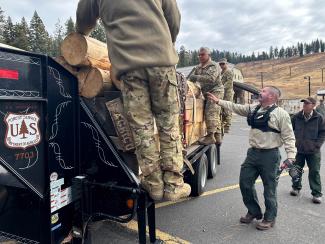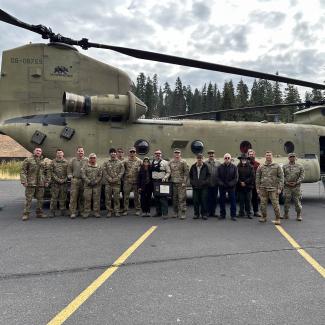Flying Wild
Stanislaus partners with Cal Guard to deliver critical supplies
Kimberly Hill, Stanislaus National Forest

SONORA, Calif— When venturing out in the Sierra Nevada wilderness, the hum of a helicopter is probably the last sound you expect to hear while making your way through the pristine, yet rugged, terrain.
But when supplies need to be delivered to repair a cultural site in the middle of the wilderness, the nature and isolation that draws people to the area can soon become obstacles to Forest Service employees.
Luckily, they have a partner to call on for special deliveries!
Stanislaus National Forest collaborated with the 1-126th Aviation Regiment, California National Guard to deliver critical supplies to remote areas of the forest near Cooper Meadow in the Emigrant Wilderness, Oct. 30, 2024.
“It provided a great experience and training for our aircrews that we cannot replicate as much as we’d like,” said U.S. Army Capt. Patrick Koeneke, commander of B Co., 1-126th General Support Aviation Battalion.
The Wilderness Act of 1964 established the National Wilderness Preservation System and authorizes Congress to designate wilderness areas. An area of wilderness is defined to mean in this Act an area of undeveloped Federal land retaining its primeval character and influence.
There are over 800 wilderness areas in the United States, managed by different land agencies, to include the National Parks, Bureau of Land Management, U.S. Fish and Wildlife Service and the Forest Service.
With these challenges, forests like the Stanislaus must become creative in their efforts to preserve these sites. This often means reaching out to their partner agencies, like the California National Guard.
Utilizing CH-47 Chinook helicopters from Bravo Company, 1-126th Aviation, Soldiers were able to transport materials that will be used to preserve the cultural site. The location, like many sites in the wilderness was inaccessible by road, in high-altitude, mountainous terrain.

California National Guard Soldiers unload timber that will be used to conserve a cultural site.
Photo Credit: California National GuardThe Soldiers gained experience in sling-loading irregular cargo loads, a skill that directly benefits response capabilities in California’s complex terrain, said U.S. Army Sgt. 1st Class Amanda Johnson, public affairs specialist with the California National Guard.
“We are a heavy-lift helicopter company, so sling loads are our bread and butter. We practice them weekly with our training blocks, and it was a great opportunity to have a real-world sling load and personnel to work with,” said Koeneke
With the critical supplies delivered, the forest service can begin the process of preserving the cultural site, so that it can be around for generations of visitors to enjoy.
"This was as an invaluable training opportunity for both teams, highlighting their shared commitment to readiness and resourcefulness,” said Shawn Winstead, district ranger for the Summit and Mi-Wok District of the Stanislaus NF.

California National Guard Soldiers and Forest Service employees pose for a group photo after collaborating on a supply delivery.
Photo Credit: California National GuardThe collaboration also enabled Forest Service personnel to witness firsthand expertise of the National Guard, while Guard members familiarized themselves with the logistical challenges of forest management, preparing both agencies for future missions that may require rapid mobilization and coordination across rugged landscapes, said Winstead.
The mission strengthened the relationship between the USFS and California Army National Guard, showcasing the critical role partnership plays in natural resource management and emergency response.
“The success of this operation underscores the power of interagency collaboration in achieving common objectives, ensuring both the Stanislaus National Forest and other vulnerable landscapes receive the support they need in times of crisis,” said Winstead.


